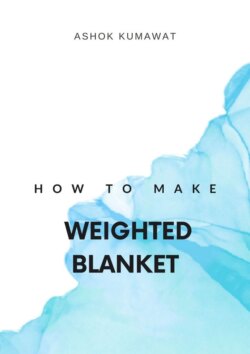Читать книгу How to make weighted blanket - Ashok Kumawat - Страница 7
На сайте Литреса книга снята с продажи.
Chapter 5: Exploring Different Blanket Fillings
ОглавлениеThe choice of filling material for your weighted blanket is crucial as it not only determines the overall weight distribution but also impacts the comfort and effectiveness of the blanket. In this chapter, we will explore various options for blanket fillings, discussing their properties, benefits, and considerations to help you make an informed decision when selecting the ideal filling material for your weighted blanket.
Section 1: Poly Pellets
Poly pellets, also known as polypropylene pellets, are one of the most common and widely used fillings for weighted blankets. They are small, round plastic beads that provide a consistent weight distribution throughout the blanket. Poly pellets are non-toxic, hypoallergenic, and washable, making them a practical choice. They offer a smooth and even feel, ensuring that the weight is evenly distributed across the blanket.
Section 2: Glass Beads
Glass beads are another popular choice for filling weighted blankets. These tiny, smooth beads are made from tempered glass and are often considered a more eco-friendly alternative to plastic fillings. Glass beads provide a gentle and comforting weight distribution, allowing for a more precise and customizable feel. They are non-toxic, hypoallergenic, and produce less noise compared to other fillings. However, they may require additional care during washing and drying to avoid breakage.
Section 3: Steel Beads
Steel beads are a heavier option for weighted blanket fillings, offering a denser and more substantial weight. They provide a firm and grounding sensation, making them suitable for individuals who prefer a greater amount of pressure. Steel beads are durable and long-lasting, ensuring the longevity of your weighted blanket. However, it's important to consider that they can be noisier compared to other fillings.
Section 4: Natural Fillings (Rice, Beans, or Grains)
For those seeking a more natural and budget-friendly option, rice, beans, or grains can be used as fillings for a weighted blanket. These organic fillings offer a unique texture and can provide a comforting warmth when heated. However, it's essential to consider that natural fillings may not be as durable as synthetic options and may require additional care to prevent spoilage or infestations.
Section 5: Combination Fillings
Combining different filling materials can allow you to customize the weight, texture, and feel of your weighted blanket. For example, you can mix poly pellets with glass beads or use a combination of natural and synthetic fillings. This approach allows for versatility and the ability to tailor the weight distribution and sensory experience according to your preferences.
Section 6: Weight Considerations
When selecting a filling material, it's important to consider the weight range you desire for your blanket. Some fillings, such as poly pellets, are lighter in weight, while others, like steel beads, are denser and heavier. By selecting the appropriate filling material, you can achieve the desired weight and pressure for your weighted blanket.
Section 7: Practical Considerations
In addition to comfort and weight, practical considerations should also be taken into account when choosing a filling material. Consider factors such as washability, hypoallergenic properties, and noise levels. Opting for fillings that are easy to clean, hypoallergenic, and produce minimal noise can ensure that your weighted blanket remains hygienic, comfortable, and suitable for various individuals.
Section 8: Safety considerations
Safety is paramount when selecting a filling material for your weighted blanket. Ensure that the chosen filling is non-toxic, free of harmful chemicals, and does not pose any choking hazards. It is also essential to secure the fillings properly within the blanket to prevent shifting or leakage, which could compromise the safety and effectiveness of the weighted blanket.
Section 9: Customization and Personalization
The choice of filling material for your weighted blanket allows for customization and personalization. You can experiment with different fillings to find the one that best suits your preferences and needs. Additionally, you can adjust the amount of filling used to achieve the desired weight and feel, ensuring a truly customized and tailored experience.
In conclusion, selecting the ideal filling material for your weighted blanket is crucial for achieving optimal weight distribution, comfort, and effectiveness. Whether you choose poly pellets, glass beads, steel beads, natural fillings, or a combination thereof, each filling material offers its unique properties and benefits. By considering factors such as weight, practicality, safety, and customization, you can make an informed decision and create a weighted blanket that perfectly suits your needs and preferences.
